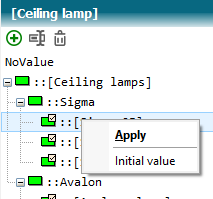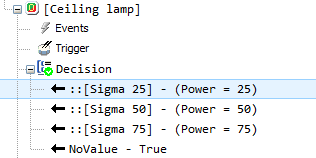

 By
clicking on the symbol in the object properties, a new decision control can be
created.
By
clicking on the symbol in the object properties, a new decision control can be
created.
Decision controls do not require the switch “Rules” has to be set.

|
Property |
Description |
|
Always allowed |
If the switch is set, the decision control is allowed and is executed during the rule check, unless a prohibition rule prevents execution. If the switch is not set, a permission rule must be used to determine under what circumstances the control is executed. |
|
Index |
If the variable is a list, it is necessary to specify which index in the list is controlled. The smallest index is zero (0). |
 A
permission rule can be created by clicking on it. A permission rule determines
the conditions under which the decision control is executed. A permission rule
only makes sense if the Always Allowed switch is switched off.
A
permission rule can be created by clicking on it. A permission rule determines
the conditions under which the decision control is executed. A permission rule
only makes sense if the Always Allowed switch is switched off.
 A
prohibition rule can be created by clicking on it. A prohibition rule determines
the conditions under which decision control is not executed.
A
prohibition rule can be created by clicking on it. A prohibition rule determines
the conditions under which decision control is not executed.
Setting a decision entry

By selecting the Apply function, a class can be transferred to the decision control list.
Selecting multiple classes builds up a list of entries that are processed in the decision control.

Each entry has a rule that determines when the class should be assigned to the object.
The decision control is performed from top to bottom during the rule check. On a hit, the class is assigned to the object and the decision control execution is completed.
If a matching rule is not found, the decision control has no effect.